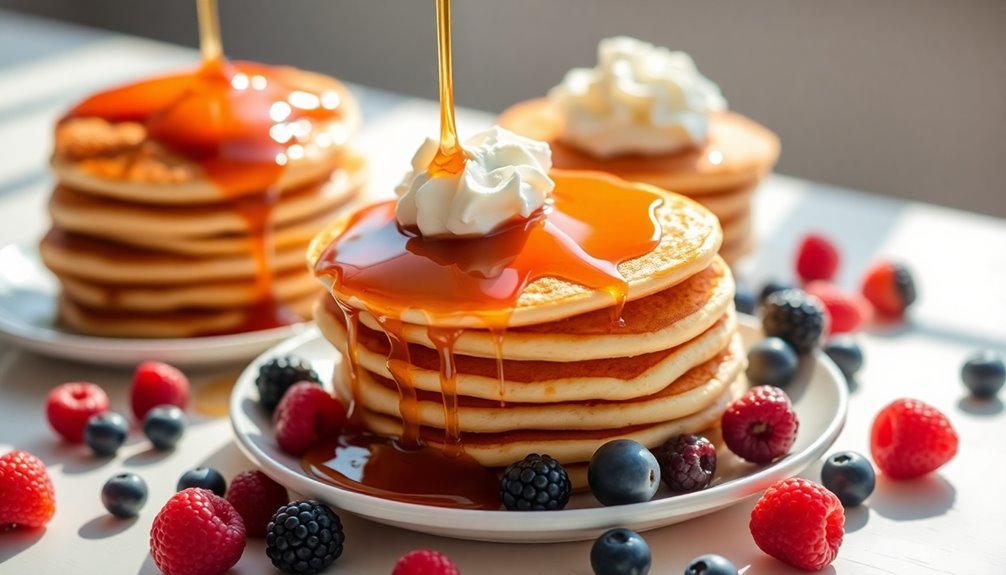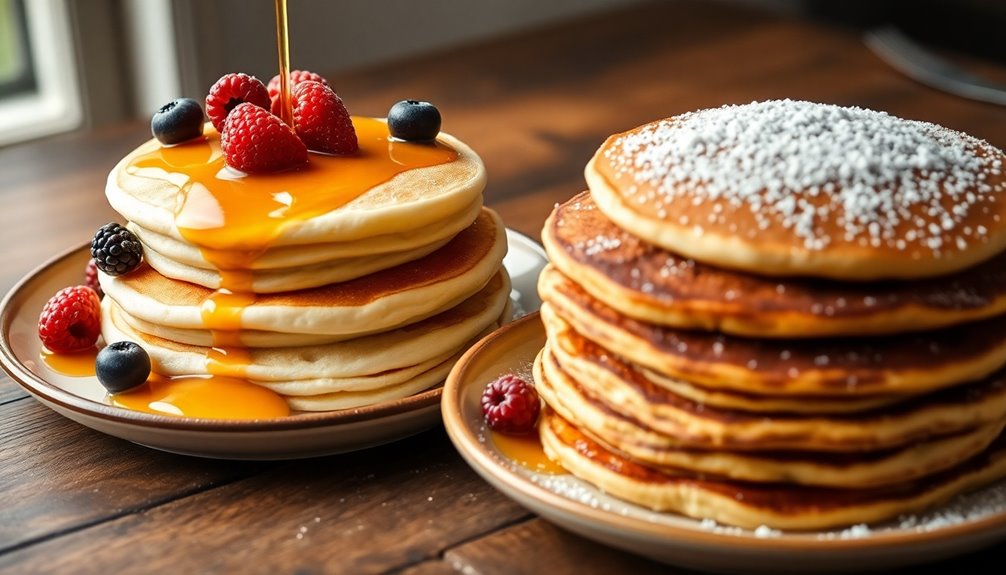Buttermilk pancakes are a game-changer compared to regular ones. They boast a richer, tangy flavor and have a light, fluffy texture that's hard to beat. The unique acidity of buttermilk not only activates baking soda for better rise but also adds moistness. Plus, it's packed with probiotics for gut health, which regular milk can't match. If you're looking to elevate your breakfast experience, you might want to explore what makes buttermilk pancakes even more special.
Key Takeaways
- Buttermilk pancakes are fluffier due to the reaction between buttermilk's acidity and baking soda, creating air bubbles.
- The tangy flavor of buttermilk enhances the overall taste, providing a richer experience compared to regular milk.
- Buttermilk contributes to a moister texture, resulting in soft and tender pancakes preferred by many.
- Traditional buttermilk contains probiotics, offering gut health benefits that regular milk lacks.
- Using buttermilk supports a healthier lifestyle while enjoying a flavorful breakfast option.

Have you ever wondered what sets buttermilk pancakes apart from regular ones? The difference lies in the unique ingredients and chemical reactions that create those fluffy, delicious stacks of joy.
Buttermilk pancakes stand out primarily because of the interaction between buttermilk's acidity and baking soda. When you use buttermilk, the acidity activates the baking soda, producing carbon dioxide. This reaction creates air bubbles in the batter, giving buttermilk pancakes their signature height and fluffiness.
The flavor of buttermilk pancakes is another game-changer. The tangy taste that comes from lactic acid bacteria in buttermilk enhances the overall pancake experience. You'll find that this rich flavor adds a complexity you just don't get with regular milk. Regular milk gives you a milder taste, which can be pleasant, but it doesn't compare to the depth that buttermilk brings to the table. This richer flavor profile is especially evident when you drizzle maple syrup or add fruit toppings.
The texture is equally impressive. Buttermilk's creamy consistency helps retain air bubbles while cooking, resulting in a moister pancake that's less dense than those made with standard milk. When you take a bite, you'll notice how light and fluffy they are, making them a delightful breakfast option. This moistness is a significant advantage, especially if you enjoy your pancakes soft and tender.
If you're considering switching from regular milk to buttermilk in your pancake recipe, you'll want to make a couple of adjustments. It's recommended to cut the baking powder by half and add baking soda to maintain that ideal rise and texture. This simple tweak guarantees your pancakes turn out just as fluffy and delicious as intended.
Lastly, let's not forget the health benefits. Traditional buttermilk contains beneficial probiotics, which can contribute positively to gut health. Regular milk doesn't offer these fermented properties, so if you're looking to up your health game while enjoying your breakfast, buttermilk is the way to go.
Frequently Asked Questions
Are Buttermilk Pancakes Better Than Regular Pancakes?
When you compare buttermilk pancakes to regular pancakes, you'll notice some key differences.
Buttermilk pancakes tend to be taller and fluffier, thanks to the reaction between buttermilk's acidity and baking soda. You'll also enjoy a richer, tangy flavor that regular pancakes can't match.
Plus, the creamy texture helps keep them moist. If you're after a special breakfast treat, you might find buttermilk pancakes to be the better choice for flavor and texture.
What Is the Secret to Fluffy Pancakes?
To achieve fluffy pancakes, focus on a few key techniques.
First, let your batter rest for about 10 minutes to relax the gluten.
Use fresh baking powder to guarantee proper lift, and avoid overmixing, which can make your pancakes dense.
Incorporating whipped egg whites can add extra fluffiness, as the air bubbles expand while cooking.
Finally, consider using buttermilk, as its acidity reacts with baking soda, creating a light, airy texture.
What Milk Is Best for Pancakes?
Imagine flipping a stack of golden-brown pancakes, their fluffy height beckoning you.
When it comes to milk, whole milk's your best bet for a rich, creamy texture. It elevates the flavor and keeps your pancakes moist.
If you want a lighter, fluffier result, consider using buttermilk. The acidity reacts with baking soda, creating that perfect lift.
What Is the Healthiest Way to Eat Pancakes?
To enjoy the healthiest pancakes, start with whole grain flours like whole wheat or oat flour for extra fiber.
Add fruits like bananas or blueberries to boost nutrients and flavor.
Replace butter with unsweetened applesauce or Greek yogurt to cut saturated fats while keeping them moist.
Use natural sweeteners like honey in moderation, and top your pancakes with protein-rich options like nut butter or Greek yogurt to keep you satisfied longer.
Conclusion
When it comes to buttermilk versus regular pancakes, it really boils down to personal preference. If you're after that rich, tangy flavor and fluffy texture, buttermilk's the way to go. On the flip side, regular pancakes are a classic choice that can be just as satisfying. Whichever you choose, both options will bring a smile to your face and make your breakfast sing. So, grab your favorite syrup and dig in—you can't go wrong either way!








